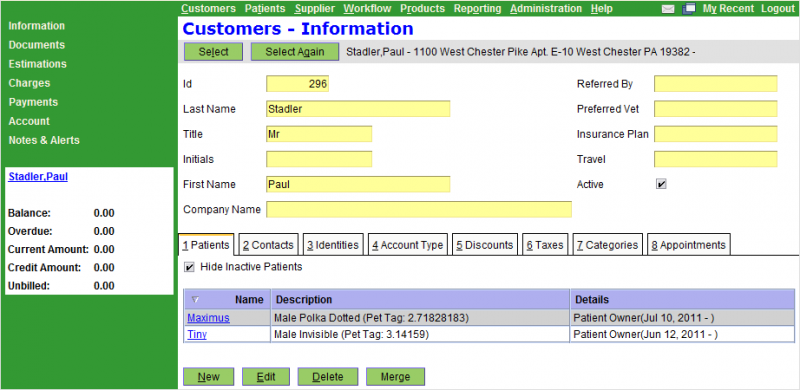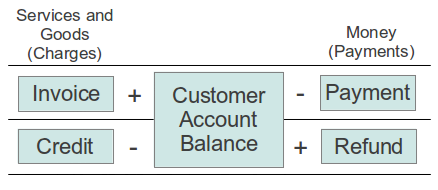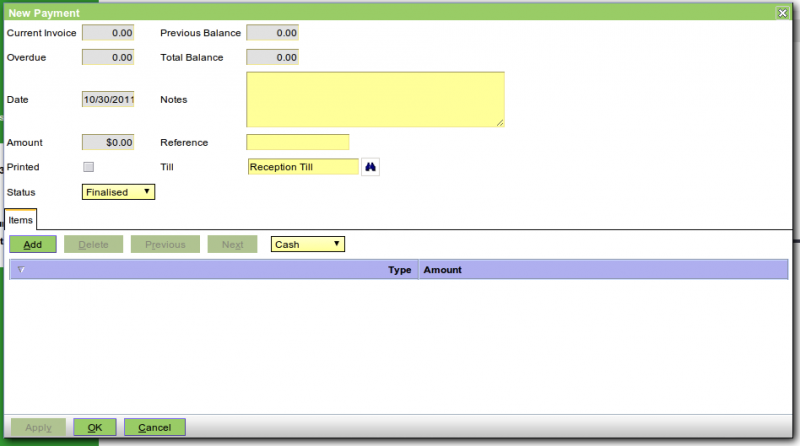Customers
This section is meant to deal with the customers section of OpenVPMS. In this section, you'll find all functions regarding customer interaction. These include billing, payments, basic information, patient lists, notes and alerts, et cetera.
The pages below represent each of the main functions that you can accomplish in this module. These pages are not meant to be specific to any submenu within the customers sections because some activities require probing into multiple submenus. Dealing with customer accounts is certainly one of these.
Basic Customer Information
We can get a pretty good handle on what types of information are in this screen by looking at the screen itself.

While the most basic information is shown directly on this screen, there are several other types of information that are in the tabs toward the bottom of the screen (Patients, Contacts, Identities, etc.). We'll step through all the elements of this screen.
Actions
The action buttons at the bottom are most likely fairly familiar to you at this point. Here's a description of their functions:
- New: Create a new customer
- Edit: Edit the current customer
- Delete: Delete the current customer
- Merge: Merge this customer into another customer
 Tip: The "Merge" button, as shown above will not appear unless you're logged in as administrator.
Tip: The "Merge" button, as shown above will not appear unless you're logged in as administrator.
Name and other Basic Information
The information that's shown right on this screen is the basic information. Here we must enter, at a minimum the name of the customer. All other fields are optional, but highly recommended.
 Tip: In general, if there is a single value associated with a record (like Customer and Name), it will show in the main window. If there can be multiple values associated, then it is a list -- and will appear slightly differently, as some of the information in the tabs.
Tip: In general, if there is a single value associated with a record (like Customer and Name), it will show in the main window. If there can be multiple values associated, then it is a list -- and will appear slightly differently, as some of the information in the tabs.
 Tip: Your system administrator can configure your system to change the default value of the Title field, or any other pull-down type field.
Tip: Your system administrator can configure your system to change the default value of the Title field, or any other pull-down type field.
Further Customer Information
The rest of the information for a customer is housed in the tabs toward the bottom of the screen. We'll discuss each one. Note that we won't put a screenshot of each one in this document, but you're encouraged at this point to click through each tab and get a feel for what information lives in each.
Patients
The patients tab is a list of patients for the current customer. You can add and remove patients to the current customer here. OpenVPMS is flexible in the way it handles the relationships between patients and customers. It's possible to have multiple owners associated with a single patient, as well as the more typical multiple patients to a single owner. Here, however, we're just showing what patients are associated with this customer.
It is also possible to add patients from here. When editing the record, and searching for a patient to add, you can click the "New" button directly from the search box and it will jump to the new patient screen. The details of this are covered further in the Patients section.
Contacts
All different types of contacts are consolidated into this one tab. The screenshot below shows this tab under the customer edit dilaog.
 Tip: The customer edit button edits the entire customer record, not just the current tab or field.
Tip: The customer edit button edits the entire customer record, not just the current tab or field.

As shown in this field, using the list edit modality (as discussed previously), you can add numerous types of contact information into this list. Contacts consist of Addresses (Location), Phone, Email, and Fax types of contact.
Often the system will look for this type of information when printing forms, invoices, or other types of documents. Forms will pull either a) the preferred contact address (there's a checkbox for that), or b) the first contact location the system encounters. For this reason, you must have at least one location and phone contact per customer.
Other Customer Functions
There are several other customer related functions that you can find in this section. They're not used as often, but are important to know about.
Documents
The documents section allows you to store documents associated with the customer. The types stored here are: Attachments, Forms, and Letters.
Estimations
Estimations are almost the same as invoices. The only difference is that they allow you to specify a minimum and a maximum for certain charges, mainly those that have a quantity attached.
Notes & Alerts
This is a general function that allows you to store notes and alerts about the customer. Alerts will show up the same way that patient alerts will show up - right in the current customer information area. Depending on your configuration, you may have certain pieces of information that you'd ilke to be sure are seen in reception. This make good alerts.
Payments, Charges, and Accounts
Account Basics
There are 4 primary types of transactions that are used to manage customer accounts in OpenVPMS: Invoice, Credit, Payment, and Refund. Understanding the relationship between these is necessary to being able to handle tasks such as invoicing customers.
 Let's start with this basic chart. This will become more clear as we discuss below. Basically, the four transaction types can be broken into smaller groups. Also, please note here that a positive account balance means the customer owes the practice money, not the otherway around.
Let's start with this basic chart. This will become more clear as we discuss below. Basically, the four transaction types can be broken into smaller groups. Also, please note here that a positive account balance means the customer owes the practice money, not the otherway around.
There are transactions that influence a customer's account because something happened, or some good changed hands. These are invoices and credits. Invoices and credits are opposites.
There are other transactions that represent the transfer of money. These are payments and refunds. Payments and refunds are opposites.
 Tip: When a good is returned, a credit is processed, not a refund. A refund can later be processed if the customer wants money back, instead of having a negative account balance.
Tip: When a good is returned, a credit is processed, not a refund. A refund can later be processed if the customer wants money back, instead of having a negative account balance.
Navigation
In the Customer screen, there are 3 areas for working with transactions: Charges, Payments, and Account.
- Charges: For creating invoices and credits (returns).
- Payments: For creating payments and refunds.
- Account: For viewing all (finalized) account history. This is also used for more advanced transaction types - account adjustments.
As you can see, the opposites are grouped together.
Charges
Managing these transaction types generally means creating them, and then finalizing them. OpenVPMS allows for staging of each of these transaction types. This is very useful when trying to get ahead of the work. For instance, if you know a customer is coming to pick up a prescription later in the day, you can create that invoice immediately, and leave it in the staging area. It becomes a "Work in Progress". These are discussed further in the Reporting section.
Once an invoice is truly complete, generally just before the customer pays, it must be finalized. This moves it to the account balance, and out of the "Work in Progress" state.
 Tip: Once finalized, transactions cannot be edited. This is to ensure proper accounting.
Tip: Once finalized, transactions cannot be edited. This is to ensure proper accounting.
To create a new invoice, go to Charges and click "New", then select "Invoice". You will see a window appear that allows you to add sale items.

Once the invoice screen appears, you can add as many items as you wish. Note that you can override prices as you go. When you've completed all of them, click on "Ok". Note that this does NOT finalize the invoice. You've completed editing it, but you haven't actually billed the customer yet.
Once you're sure that it's ready to bill, click on the "Finalize" button. At this point, OpenVPMS will ask if you'd like to make a payment. This is a convenience because finalization almost always occurs just before a payment (you wouldn't otherwise be able to know if the customer wanted to purchase something more). If you click "Yes", it will jump to the payments section, as described below.
Payments
The payments area is simpler than charges because there is no staging area. It here we have basic payments, and refunds.
A refund would be useful if the customer had a negative account balance perhaps as a result of a credit (return). A refund is what allows the practice to pay him back for that refund. It will most likely be the least
In order to create a new payment, go to Payments and click "New", then select "Payment". You will see a window appear that allows you to add payment types.

Next, click on the type of payment you would like to receive (Cash, Credit, etc). Once you've created the line-item, you can fill in the details for the payment. When done, click "Ok".
Note that OpenVPMS uses a list edit style for payments. The reason is because some customers will want to pay with multiple tender types. They may have some cash in their pocket, but want to cover the rest with a credit card. You can add multiple payment types by repeating the steps above with a different selection (before clicking "Add").
 Tip: On cash transactions, after you've entered the tendered amount, hit Enter and OpenVPMS will calculate the change for you.
Tip: On cash transactions, after you've entered the tendered amount, hit Enter and OpenVPMS will calculate the change for you.
Workflow
As an aside, the workflow takes you through most of the steps above. There is no need to manually go and create an invoice. It is done automatically as part of the workflow. There are more details about this in the Workflow section.
Account
The account section displays a list of all transactions against a particular customer account. You can click on each one and see the details of it.
This section also has a facility to create more advanced transaction types. These can be created by clicking on the "Adjust" button. Here's an overview of each one:
- Credit Adjustment: Decrease the customer account balance.
- Debit Adjustment: Increase the customer account balance.
- Initial Account Balance: Self explanatory.
- Customer Bad Debt: Used for writing off debt.
 Tip: Each transaction type above allows you to type notes along with it. Particularly in the advanced transactions, it is important to note why the transaction is being entered.
Tip: Each transaction type above allows you to type notes along with it. Particularly in the advanced transactions, it is important to note why the transaction is being entered.